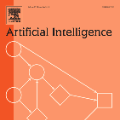Artificial intelligence (AI) has been increasingly applied in scientific activities for decades; however, it is still far from an insightful and trustworthy collaborator in the scientific process. Most existing AI methods are either too simplistic to be useful in real problems faced by scientists or too domain-specialized (even dogmatized), stifling transformative discoveries or paradigm shifts. We present an AI research associate for early-stage scientific discovery based on (a) a novel minimally-biased ontology for physics-based modeling that is context-aware, interpretable, and generalizable across classical and relativistic physics; (b) automatic search for viable and parsimonious hypotheses, represented at a high-level (via domain-agnostic constructs) with built-in invariants, e.g., postulated forms of conservation principles implied by a presupposed spacetime topology; and (c) automatic compilation of the enumerated hypotheses to domain-specific, interpretable, and trainable/testable tensor-based computation graphs to learn phenomenological relations, e.g., constitutive or material laws, from sparse (and possibly noisy) data sets.
翻译:数十年来,人工智能(AI)越来越多地应用于科学活动;然而,在科学过程中,它远非具有洞察力和可信赖的合作者;大多数现有的人工智能方法过于简单,无法用于解决科学家面临的实际问题,或者过于简单,无法用于解决科学家面临的实际问题,或者过于专门化(甚至教条化)、窒息变革性发现或范式转变;我们为早期科学发现提供了一个AI研究协会,其基础是:(a) 一种基于物理的模型的新颖的微小偏差理论,这种模型具有上下文性、可解释性和可解释性,而且可在古典和相对物理学中广泛应用;(b) 自动寻找可行和可辨识的假说,这种假说在高层次上(通过域-通性结构)具有内在的变异性,例如,假设空间时间表表所隐含的后订保护原则形式;以及(c) 将列举的假说自动汇编成符合特定领域、可解释性、可培训/可测试的多式计算图,以便学习人文关系,例如,组织或材料法和数据集的稀有的稀有。





